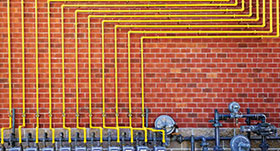

Sabrina Bochen of u-blox looks at how the LTE-M standard is making LTE relevant for smart meters.
Smart metering is not the most obvious application for next-generation cellular technology. Utility meters don’t need the high data speeds of up to 100 Mbps that are designed for consumer mobile video streaming. The amounts of sent data are small, the speed of transmission is not critical and low-power operation is desirable.
Most smart meter deployments today use 2G or 3G cellular technologies and u-blox supplies products such as the 2G SARA G family and the 3G SARA U family into these types of metering applications. So, with 2G and 3G metering applications already so well established, why are some parts of the industry calling for smart meters to be upgraded to 4G technologies?
There are actually several good reasons why 4G technologies such as LTE (long term evolution) are applicable to smart meters. One of the most obvious is that by upgrading to the latest technology, utility meters are being future proofed as far as possible. With 2G and even 3G networks undergoing switch-off in some markets, they are just not compatible with the decades of service that are required from utility meters. The safest way to ensure service in the future is to opt for the most advanced technology available today, which is LTE. Mobile operators around the world are investing heavily to ensure that it lasts well into the 2020s and beyond.
Another reason 4G applies to smart meters is that the latest version of LTE includes LTE-M, a new part of the specification designed specifically for machine to machine communications. LTE-M standards such as Category 1, Category M1 and NB1 (also known as NB IoT) are optimised for the high numbers, low data complexity levels and low power needs of widespread sensor networks connected to the Internet of Things (IoT). Cellular communications modules that support these new standards are already available (such as the LARA R2, TOBY R2, SARA R4 and SARA N2 series, which all support LTE Cat 1, Cat M1 and NB1 standards).
Category M1 in particular allows LTE to cost effectively support low data rate applications in a wide range of IoT applications. Its range is up to 100 km with a maximum data rate of around 1 Mbps, and its power efficiency means a utility meter can expect up to 10 years of battery
powered operation. While a peak data rate of 1 Mbps might seem like overkill for transmitting home energy usage information, there are times when a higher data rate is needed, such as when the utility needs to update the meter’s firmware. This is essential, if meters are to maintain a high level of operational security over decades. Firmware will need to be updated and patched to ensure security from wide scale attacks such as from hackers or terrorists, as well as prevent tampering by unscrupulous users wanting to reduce their bills.
Comparing LTE Cat M1 to some of the other low-power networking technologies out there (such as LoRaWAN) underlines Cat M1’s suitability for utility metering. Cellular standards are already rolled out globally, with more than 300 LTE networks deployed in 110 countries covering a very high percentage of populated areas, and mobile network operators have responsibility for installing and maintaining the entire network infrastructure. These networks are globally interoperable and easy to integrate with billing systems. Compared to other networking topologies, such as connecting meters to the Internet via home Wi-Fi connections, cellular also offers excellent reliability.
Cellular standards offer a level of interoperability with consumer devices that allows for straightforward two-way communication between smart meters and smart home appliances that use energy. This could be used to switch appliances on during off-peak hours to reduce consumer utility bills. Compared to Cat 1, Cat M1 has extended range (155,7 dB MCL), allowing signals to pass through more walls and floors for whole home connectivity. Operating on cellular networks also allows easy interconnection with services outside the home that communicate using this technology either now or in the future. This could help bring utility meters into a network that includes waste collection services (smart bins), parking controls, street lighting and many others.
While 4G in its consumer smartphone format isn’t the right choice for low data rate services, the introduction of the LTE-M standard has made 4G cellular technology the front runner for smart utility meter connectivity for technical, economic and coverage reasons. LTE’s new machine-to-machine standards also effectively guarantee mobile network operators’ support for metering data traffic now and in the years to come.
For more information contact Andrew Hutton, RF Design, +27 (0)21 555 8400, [email protected], www.rfdesign.co.za
| Tel: | +27 21 555 8400 |
| Fax: | 086 653 2139 |
| Email: | [email protected] |
| www: | www.rfdesign.co.za |
| Articles: | More information and articles about RF Design |
© Technews Publishing (Pty) Ltd | All Rights Reserved